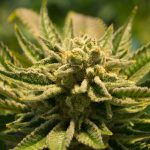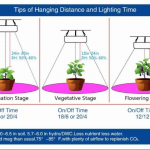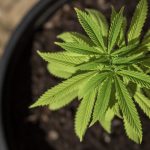There are various ways that you can grow cannabis. One of the most natural methods is by asexual propagation, a technique mostly known as cloning. But how does this process work? The process involves taking shoots or branches of a donor cannabis plant and inducing the formation of roots in a separate growing medium. The clone cuts then become identical to the mother plant as it carries similar genes. Therefore, if the mother plant is female, all the clones you get from it will be female. A cannabis grower can make as many cuttings from a single plant if they want to maintain the same characteristics as the mother plant.
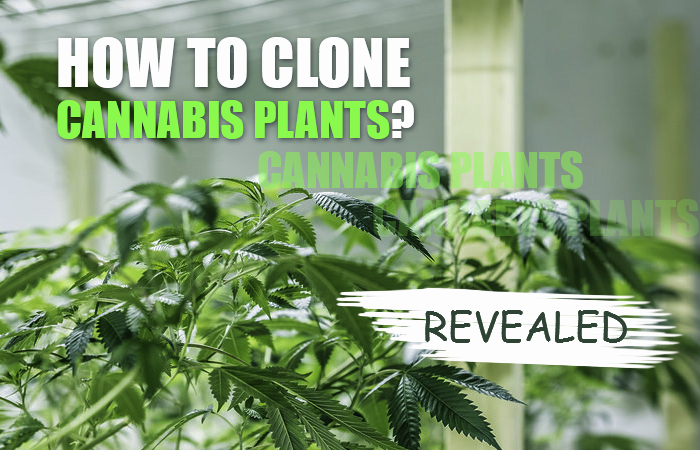
Several benefits come with cloning a marijuana plant. For one, cloning helps you get a constant supply of healthy female plants. Since clones are genetic duplicates of their parent, you should only use the best plants as the mothers. It will help you in the creation of a marijuana garden that can last for a decade. You can keep the mother plant for a long time and use it to extract healthy offspring. However, you should note that the longer it stays alive, the more likely it will fall prey to attacks by fungi, diseases, and insects.
But why do Marijuana Growers use Clones?
Clones help the grower to ensure that the marijuana plants grow at the same pace through all the stages of their lifecycle. The plants take on a general uniformity from their growth habits, same height, flowering at the same time, and having equal yields. You should also expect the plants to have a similar potency, aroma, taste, and traits, among other characteristics. It helps growers increase their harvesting success as they know what exactly to provide their crops to get a massive harvest. Since cloning guarantees a consistent quality harvest, it is a favorable method of growing commercial weed.
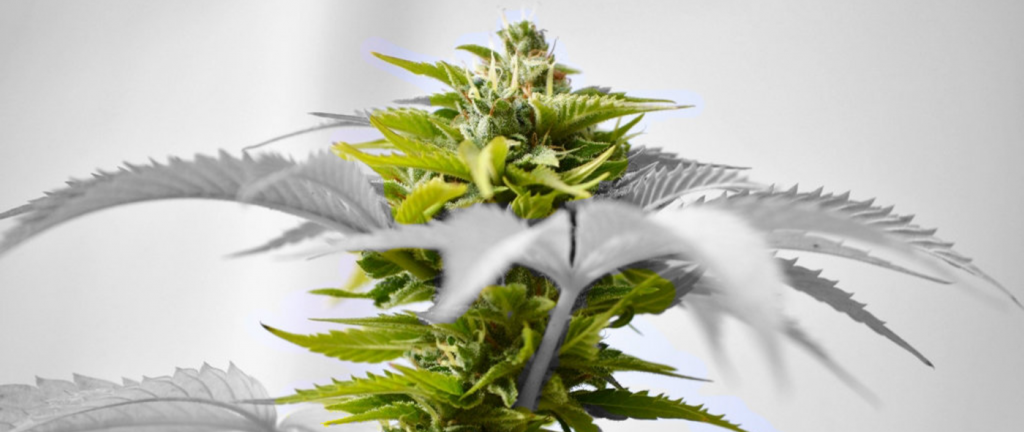
Cloning also helps to reduce the maturity time of a cannabis plant. The plants can start to flower immediately they are 12 inches tall. The total growing time from seeds to harvesting is usually 90 to 130 days. However, with cloning, you can shorten the time to only ten days. Through cloning, a grower can plant THC potent plants that grow at a rapid rate to reach their full potency.
A cloned plant that is one month old has the same characteristics as a plant in its fourth month of growth and can easily be triggered to start producing flowers.
How do you Clone weed?
Cloning is a straightforward process to master once you get it down. There are different methods you can use to clone. These include cloning in soil, water, and Rockwool. You can use either way depending on your personal preference.
Choosing the Mother plant
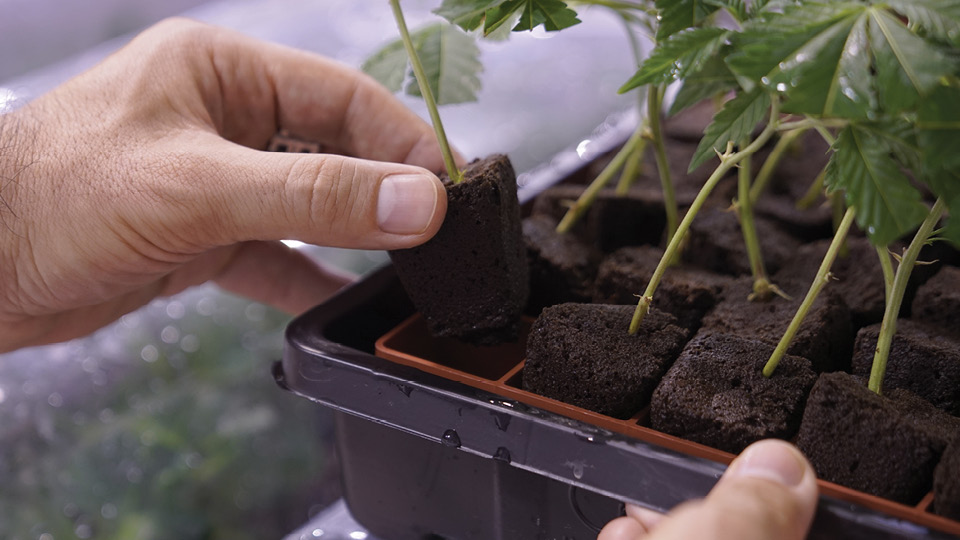
The first step to cloning is selecting a plant to be the mother. The Bonsai plant should be a healthy female that is currently in its vegetative stage and is not allowed to enter the flowering stage. It is best to use a plant that is in its 8th week of growth. Clones that come from plants younger than eight weeks may experience uneven and prolonged growth. You can convert any female plant into a bonsai mother regardless of whether it grew from seed or is a clone. You can take clones from mother plants up to their two weeks into the flowering stage. However, clones from flowering mothers may experience shock and may not root properly. It is therefore essential to always have several bonsai mother plants that are in their vegetative stage if you want to ensure a consistent source of clones. It is best to start new mothers from seeds every year if you’re going to have maximum high quality bud production.
One habit professional cannabis growers engage in is foliar feeding the bonsai mothers a Nitrozyme kelp extract formula that is rich in growth hormones a few days to the cloning. The formula aids in the healthy and lush growth of shoots.
Growing A Bonsai Mother
- Lighting
When producing a bonsai mother plant, you need to provide it with a lighting coverage of 18 to 24 hours. By placing the mother plant under 24 hours of constant light, it tricks the plant to think that it is summer. The marijuana plants thus have a hard time flowering. However, this may trigger a growth that is faster than necessary.
[amazon box=”B07CYXT8R1″ grid=”1″]When under 18 hours of light and 6 hours of darkness, the growth of the plant eventually slows down. The plant can then get a few hours to rest, and you can be stress-free with a low electrical bill. The main disadvantage to using the 18/6 light pattern is some plants may begin to develop flowers, especially is the mother plants stay for a long time.
Generally, the type of strain you are growing determines which light is suitable for use. Pure Sativa strains can cope well with staying under 24 hours of light. Stable Indica strains, on the other hand, can deal with light under the 18/6 pattern. Even so, using the 18/6 light pattern is not fully certified as it is still experimental. You need to provide your cannabis plants with 1200 lumens of blue spectrum light.
- Nutrients
During the vegetative growth stage, you need to feed the bonsai plant with a nitrogen fertilizer. A week to the cutting, you can lower the amount of nitrogen you are feeding the plants and increase the amount of phosphorous. Before cloning, there are several steps that you should take to prepare the plant for cloning. You need to stop providing your mother plant with nutrients a few days to cloning. By doing so, you can reduce the amount of nitrogen that is in the leaves of the marijuana plant, increasing the chances of the cuttings taking root during cloning. When the plants have too much nitrogen, they may continue to develop vegetative growth and not allow the growth of new roots.
An example of nutrients you can use is the House & Garden Soil A + B Set 1 Liter.
House & Garden Soil A + B Set
[amazon box=”B003N3950C” grid=”1″]The House & Garden Soil A + B Set are one of the best nutrients you can use on your cannabis farm. You can use it on either soils, coco coir or in a hydroponic setup. It is well attuned to providing nutrients for both the growth and flowering periods. Its main component is a liquid with trace elements. The formula does not contain any bulking agents. It enables plants to absorb the nutrients fast and effectively.
Taking the Cuttings
The next step to cloning is taking the cuttings. The best way forward is getting the cuttings from the lower branches of the marijuana plant. You need to select the branches that look to be the healthiest carefully. The branches should be 8 to 10 inches long and should have several nodes. The type of growing medium you use can also determine how you need to make your cuttings. If you use Rockwool as your growing medium, you need to cut the stem to the same size or size as close to the rooting hole as possible.
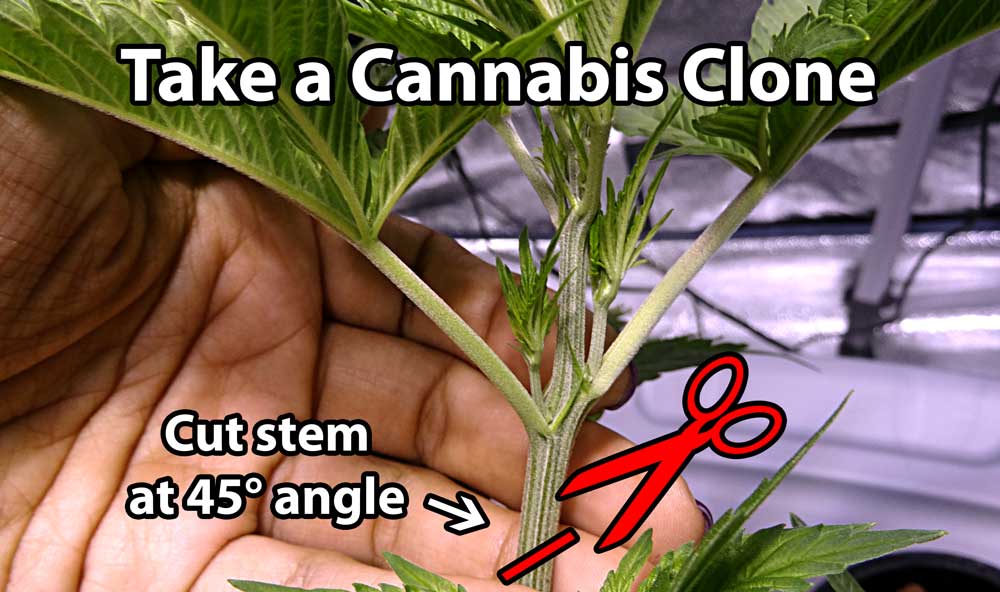
Ensure that you maintain a 45-degree angle for all your cuttings. By doing so, you increase the surface area for the development of roots. If your cuttings have broad leaves, you should reduce their size by half to increase the focus of growth of the roots.
Taking Cutting From A Flowering Plant
Taking cannabis clones from an already flowering plant is a risky gamble you should not make. It will take about two weeks for clones from a flowering plant to start producing vegetation again. The buds may take even longer for their reabsorption. The development of the roots is too long. The yield of the plant becomes compromised since you have never harvested any buds from the clones. It is even harder for the plant to survive. When a cutting comes from a flowering plant, its roots may take up to three times longer to develop. It may also not have enough stored energy to last for a long time. The best recommendation is using clones from plants in their vegetative growth stage.
Number of Clones Cutting to Get
Every clone cannot be the same. There are those that will stand out by having a poor performance while others will shine by growing rather well. When taking clone cuttings, you should take more than you need to compensate for those that perform poorly. A good starting point would be getting 50 percent more.
Encouraging Perpetual Harvesting
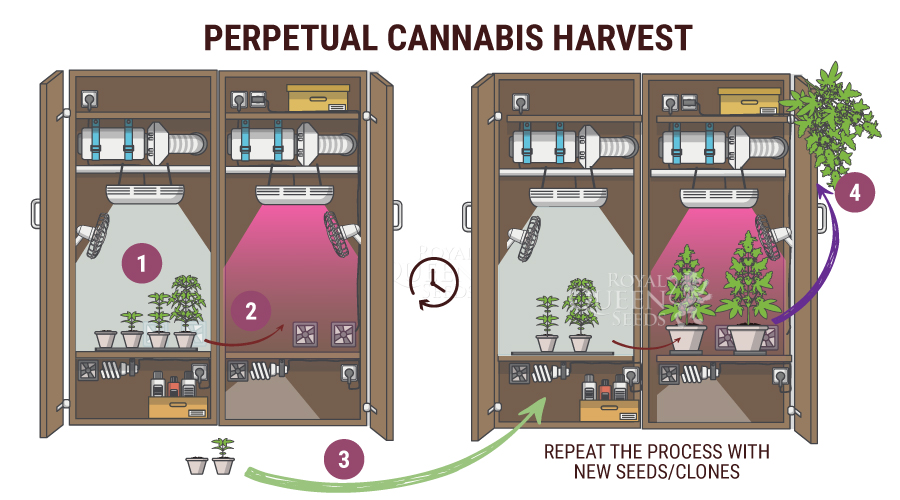
A widespread method of growing cannabis by professional growers is the use of two grow rooms. One grow room is for nurturing bonsai mothers while the other is especially for growing marijuana for flowering. By using these two grow rooms, the grower can implement an eight-week flowering-harvesting cycle while continuously cloning. A farmer can take out two clones after every four days and still harvest a ripe plant. For every plant that is collected, one or two rooted clones are then transferred to the flowering room.
The main idea is for each cannabis harvest; there is a clone replacement from the vegetative room. This method of growth keeps the flowering grow tent always full. With time, you will have a clear understanding of the flowering and cloning timelines, and you can then control your plants always to have full occupancy. This method of growing cannabis is ideal if you want to produce multiple strains that do not have the same flowering times.
For hydroponic systems, you need to have a good setup that allows you to move the plants around under the light since they will be of different sizes. The hydroponic system should allow you to position the plants anywhere in the grow tent as well as transfer them from one grow tent too another. Some hydroponic systems that can enable such movements include drip and ebb/flow systems. It may be challenging to maneuver in systems that have fixed plant spacing such as aero system or where roots may intertwine.
You can rejuvenate an extraordinary plant and clone it even after passing the flowering stage and being harvested. If the plant contains any vegetative matter at the bottom of the plant, you can place it under light for an 18 hours cycle, and the little vegetative matter will grow into shoots. You can then clone the shoots and produce a full bonsai plant that you can use to get future clones. By following this method, you can be sure to get uniform harvests from clones that arise from your favorite plant. It removes the need to buy seeds to plant your bonsai mother plants.
Cloning Method
Once you have the bonsai plant that you intend to clone, there are several items you need to acquire to start the process. They include:
- A rooting gel or powder
- A sharp blade
- The cloning medium can be either water, soil, or Rockwool.
- A strong grow Light
- Humidity Dome for Clones
- Heating Mat
Cloning Cannabis in Rockwool
[amazon box=”B0030KJUQC” grid=”1″]One of the most popular cloning methods is by using Rockwool as a growing medium. Firstly, you need to prepare the Rockwool by soaking them in water that has a pH of 5.5 for close to 2 hours. You can then use your blade and make cutting on your bonsai mother plant at a 45-degree angle. Trim off most of the leaves on your cutting, leaving a few at the top. Apply a little cloning gel on the bottom of the cutting and insert it into the Rockwool cube.
Afterward, you should introduce lighting to the clones for a total of 18 hours every day. You can use a CFL grow light as it can provide the light needed to jumpstart the rooting process. When cloning with Rockwool, you should maintain a temperature of 70 to 75 degrees Fahrenheit and a humidity level of 90 percent. If properly used, the roots should begin to show within 7 to 12 days.
Cloning Cannabis in Soil
[amazon box=”B007ZU5YUO” grid=”1″]The simplest way you can clone your cannabis is by using soil as a growing medium. Before starting the process, you need to introduce water to the ground until it is saturated. If your soil is fertile with nutrients, you may need to flush it to prevent the cuttings from getting too many nutrients that may then hinder development. Then, make the cutting from the bonsai mother plant at a 45-degree angle, get rid of any mature leaves on the stalk. Afterward, touch the stem slightly with water before introducing the cloning gel or powder. Introduce the stalk to the already wet soil. Once you follow all the appropriate steps, the roots will begin to grow within two weeks.
Cloning Cannabis in Water
[amazon box=”B008NRQJC0″ grid=”1″]You can use this method in a hydroponic system. Here, you need to make you cut from a bonsai plant at an angle of 45 degrees. Then, you should get rid of all the mature leaves on the cutting before sticking the cutting in water. You should ensure that the water is fresh by changing it daily. It should as well have a pH of 5.5 to increase cloning success in the water. You may opt to first introduce some root hormones or cloning gel to the cuttings before sticking it to the water to increase the chances of root development. You should then place the cuttings in indirect light.
Transplanting Clones
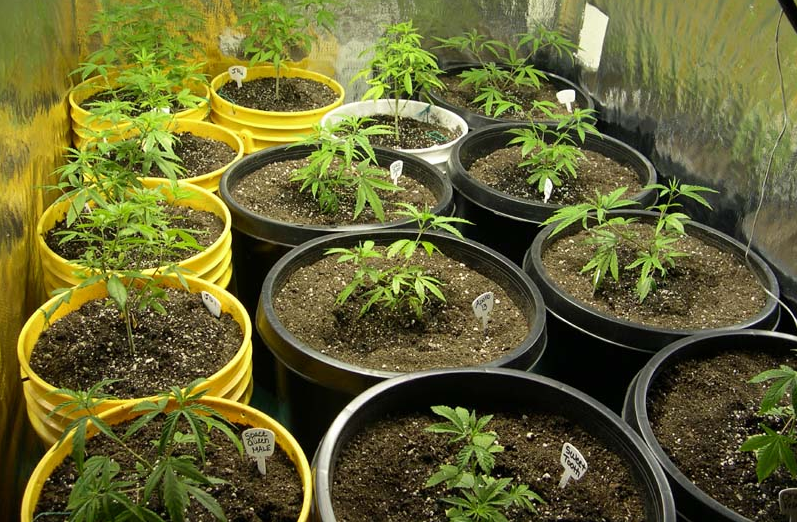
Your clone cuttings will form stable root structures in about 3 to 5 weeks. During this time, you need to transplant them into bigger containers that can accommodate their root structure. You should ensure that the growth medium you are using has a supply of plenty of air that will aid in healthy root growth.
You should make sure only transplant the firm clones with well-developed roots. To know if a clone has good roots, look out for yellow leaf tips and cuttings that grow vertically. After transplanting, you can then place the cutting directly under an HID light.
Frequently Asked Questions
When choosing the clone, which part of the cannabis mother plant should I cut?
You should choose a vigorously growing top of a bonsai plant and cut the stem that is just above the auxiliary shoot node. You have to ensure that you leave a shoot and a fan leaf on the mother plant to allow the growth of the remaining stalk. You should as well try to get a cutting that is at least 3 inches long and contains one trimmed internode.
Summing up
The above guideline touches on the basics of cloning your very own cannabis plants. To achieve even better results, you should consider putting your clones under a dome to gain control of the humidity and temperature for the development of roots. You also need to handle the cuttings with care as they are very delicate and can damage if put through harsh conditions. If you are using any rooting hormone to help with the rooting process, follow all the instructions that it carries carefully. For a dipping hormone give it a 5 to 10-second dip whereas for spray, be careful not to spray too much to the extent of the rooting hormone dripping on the leaves. By following this guideline to the last word, you can be confident of successfully growing your cloned cannabis.
Read How to Grow Cannabis Series:

